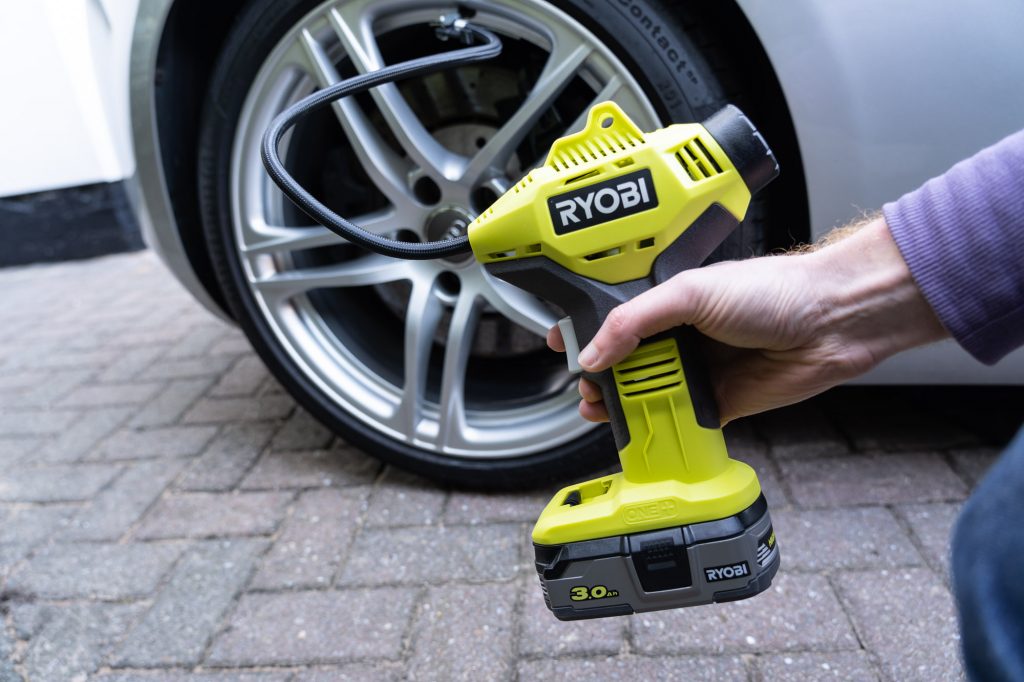
Revised and Translated for Academic Expression
Air compressors can be labor-intensive, especially when required for brief tasks such as inflating a tire or a basketball. In such scenarios, the compact and user-friendly Ryobi One+ Battery-Operated Tire Inflator proves to be a valuable solution.
Living in a climate similar to Minnesota’s, I regularly encounter the illumination of the tire pressure sensor light on my dashboard during this time of year. This necessitates either retrieving the air compressor and its associated fittings or making a brief trip to the nearby gas station for tire inflation.
During the holiday season, my father-in-law and avid golf partner, Bob, gifted me the Ryobi One+ Battery-Operated Tire Inflator. I was eager to explore its functionalities.
The Ryobi One+ Tire Inflator is a handheld, battery-operated device that is compact and lightweight, slightly larger than a standard handheld drill. Equipped with a 20-inch long air hose and a clear digital readout screen, it allows for precise adjustment of pounds per square inch (PSI). Its portability makes it suitable for various applications, such as road trips, mountain biking excursions, or inflating pool toys. The inflator includes fittings for Presta valves on bicycle tires, a needle for athletic equipment, and a cone-shaped adapter for pool floaties and small camping sleeping pads. When not in use, the fittings conveniently snap into the handle for safe storage.
Our testing procedure involved inflating a variety of items. Similar to the excitement of receiving my first store-bought slingshot as a child, I found myself inflating numerous objects in my garage. The Ryobi tire inflator was tested on the tires of my snowblower, wheelbarrow, and motorcycle, as well as on our vehicles. Additionally, various attachments were tested, including inflation of a basketball and football, Presta valve tires on two bicycles, and a kid’s pool floatie.
Performance Evaluation
The performance of the Ryobi One+ inflator proved commendable for a majority of tasks. It effortlessly inflated small floaties, sports balls, and the compact tires of the snowblower, wheelbarrow, motorcycle, and mountain bike. Notably, despite its efficient operation, the tool emitted a surprisingly loud and somewhat vexing noise attributed to the firing internal piston. Nevertheless, it navigated through these tasks with ease. Challenges, however, surfaced when attempting to inflate high-pressure road bike tires and my truck tire.
In the case of my road bike, which features narrow 32-mm wide tires with Presta valves requiring 110 to 135 PSI, the plastic Presta valve attachment seamlessly threaded onto the valve stem. However, in applications demanding high PSI, maintaining a secure, impermeable seal proved challenging without exerting force to press the nozzle onto the valve stem while triggering inflation. Notably, this issue primarily pertained to the attachment rather than the inflator itself, and it was resolved with the acquisition of a $2 aluminum Presta valve attachment from a local bike shop.
The inflation of the automotive tire presented its own set of challenges. Deliberately deflating the knobby 31-inch midsize truck tire and relying solely on the Ryobi Inflator, the task was accomplished, albeit consuming nearly 11 minutes of inflation time. The process included periodic breaks and a battery change midway through. A similar experiment with my wife’s smaller Subaru tires yielded better results, though the inflator still exhibited some difficulty inflating completely flat tires. While acknowledging the ambitious nature of the truck tire experiment, it underscored the tool’s limitations in handling severely deflated auto tires, which are a primary use case for such inflators.
Value Assessment
As is often the case with battery-operated tools, the assessment of value is subjective, considering the battery and charger constitute the pricier components. Priced at less than $40, the Ryobi One+ inflator represents an excellent value proposition. However, if the acquisition of the battery and charger is necessary, adding an additional $60 to the overall cost, alternative options may offer a more compelling value proposition.
Reliability and Durability
Over the past decade, I have owned several battery-operated tools from Ryobi, and without exception, they have consistently demonstrated reliability. The tool itself appears well-constructed, yet, due to the presence of a digital readout screen, caution is advised against casually placing it in a toolbox without adequate protection.
Ease of Use
The Ryobi One+ Inflator boasts a straightforward operational design. The nozzle, situated at the end of the 20-inch hose, easily attaches to a standard valve or one of the provided accessories, akin to a manual bike pump. Activation involves a simple pull of the trigger while monitoring the digital readout until the desired PSI is achieved. The most challenging aspect of utilizing this Ryobi One+ Inflator lies in ensuring the battery is adequately charged.
Reasons for Consideration
If you are an automotive enthusiast frequently engaged in inflating car tires, this tool may not align with your specific needs. However, if your requirements center around inflating smaller tires and sports equipment, with occasional use for topping off car tires, this tool proves to be an ideal choice. Its compact size, portability, and user-friendly nature make it suitable for on-the-go applications and straightforward enough for use by individuals of varying age groups. Moreover, for those who have already invested in other One+ tools and possess a compatible battery and charger, the Ryobi Tire Inflator stands out as an economical addition to any garage shelf or basement workshop.
Pros:
- Compact design
- User-friendly operation
- Cost-effective for existing Ryobi One+ tool owners
- Convenient onboard storage for attachments
- Clear digital readout
Cons:
- Subpar quality of the Presta valve attachment
- Effort required when inflating completely flat tires.
